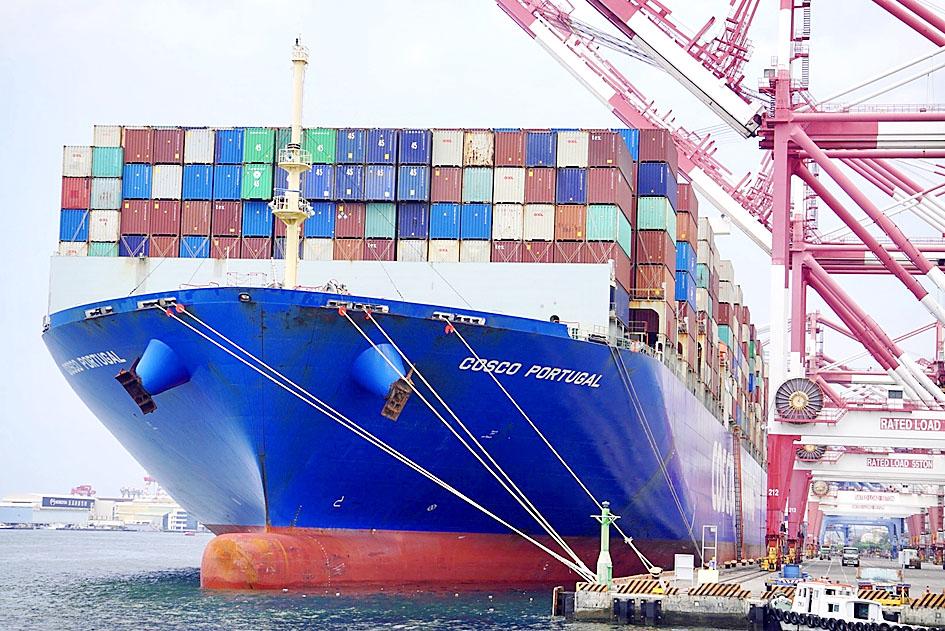Export orders grew 25.7 percent to a record US$62.9 billion last month from US$50.03 billion a year earlier, the 19th consecutive month of expansion as new smartphones launches and emerging technologies drove demand, Ministry of Economic Affairs data showed yesterday.
Export orders rose 4.5 percent from US$53.5 billion in August, the data showed.
In the third quarter of this year, orders jumped 21.7 percent annually to US$171.7 billion, the best quarter since the October-to-December period last year.

Photo: CNA
In the first nine months of this year, export orders totaled US$481.63 billion, also a record, up 32.4 percent from the same period last year.
The growth last month was led by information communications technology (ICT) products, which soared 40.1 percent year-on-year and 39.1 percent month-on-month, the ministry data showed.
Last year’s iPhone 12 was delayed from the usual September release amid the COVID-19 pandemic.
While the ministry did not name Apple Inc’s iPhone 13 by name, Department of Statistics Director Huang Yu-ling (黃于玲) said that the “delayed release of last year’s model of a popular international handset” compared with this year accounted for the unusually large year-on-year growth.
Demand for laptops and display cards remains strong, the ministry said.
“In addition to the continued strong demand for high-tech products, relatively high international commodities prices and orders for traditional industries mean that most categories experienced double-digit percentage growth,” Huang said.
The optical products industry continued to benefit from demand for larger laptop monitors, as well as for automotive and commercial use, growing 19.5 percent year-on-year, the 16th month of such growth.
Traditional sectors were not left out of the global rally, with metals, machines, petroplastics and chemicals all rising by double digit percentages.
There was an unusual amount of growth from Europe, totaling US$13.5 billion, up 53.1 percent year-on-year, the data showed.
Demand for ICT products in Europe last month grew by 69.5 percent year-on-year to US$2.87 billion, followed by electronics, which increased 50.6 percent to US$940 million, the data showed.
Export orders this month would be US$63 billion to US$64.5 billion, or year-on-year growth of 22.1 to 25 percent, Huang said, adding that such figures would extend Taiwan’s winning streak to 20 months.
“Looking forward, we still have to watch out for the COVID-19 pandemic and the electricity shortage in China, but with vaccination rates in the world’s main economic bodies rising and their infrastructure programs continuing, there should be continued growth in October for Tawianese exports,” Huang said.

WEAKER ACTIVITY: The sharpest deterioration was seen in the electronics and optical components sector, with the production index falling 13.2 points to 44.5 Taiwan’s manufacturing sector last month contracted for a second consecutive month, with the purchasing managers’ index (PMI) slipping to 48, reflecting ongoing caution over trade uncertainties, the Chung-Hua Institution for Economic Research (CIER, 中華經濟研究院) said yesterday. The decline reflects growing caution among companies amid uncertainty surrounding US tariffs, semiconductor duties and automotive import levies, and it is also likely linked to fading front-loading activity, CIER president Lien Hsien-ming (連賢明) said. “Some clients have started shifting orders to Southeast Asian countries where tariff regimes are already clear,” Lien told a news conference. Firms across the supply chain are also lowering stock levels to mitigate

Six Taiwanese companies, including contract chipmaker Taiwan Semiconductor Manufacturing Co (TSMC, 台積電), made the 2025 Fortune Global 500 list of the world’s largest firms by revenue. In a report published by New York-based Fortune magazine on Tuesday, Hon Hai Precision Industry Co (鴻海精密), also known as Foxconn Technology Group (富士康科技集團), ranked highest among Taiwanese firms, placing 28th with revenue of US$213.69 billion. Up 60 spots from last year, TSMC rose to No. 126 with US$90.16 billion in revenue, followed by Quanta Computer Inc (廣達) at 348th, Pegatron Corp (和碩) at 461st, CPC Corp, Taiwan (台灣中油) at 494th and Wistron Corp (緯創) at

NEGOTIATIONS: Semiconductors play an outsized role in Taiwan’s industrial and economic development and are a major driver of the Taiwan-US trade imbalance With US President Donald Trump threatening to impose tariffs on semiconductors, Taiwan is expected to face a significant challenge, as information and communications technology (ICT) products account for more than 70 percent of its exports to the US, Chung-Hua Institution for Economic Research (CIER, 中華經濟研究院) president Lien Hsien-ming (連賢明) said on Friday. Compared with other countries, semiconductors play a disproportionately large role in Taiwan’s industrial and economic development, Lien said. As the sixth-largest contributor to the US trade deficit, Taiwan recorded a US$73.9 billion trade surplus with the US last year — up from US$47.8 billion in 2023 — driven by strong

ASE Technology Holding Co (ASE, 日月光投控), the world’s biggest chip assembly and testing service provider, yesterday said it would boost equipment capital expenditure by up to 16 percent for this year to cope with strong customer demand for artificial intelligence (AI) applications. Aside from AI, a growing demand for semiconductors used in the automotive and industrial sectors is to drive ASE’s capacity next year, the Kaohsiung-based company said. “We do see the disparity between AI and other general sectors, and that pretty much aligns the scenario in the first half of this year,” ASE chief operating officer Tien Wu (吳田玉) told an